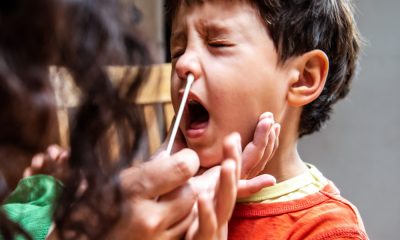It appears no one is safe from COVID even after taking an antiviral to prevent it. More and more people have reported having the symptoms again after successfully treating the condition with Pfizer’s COVID-19 pill. But scientists are slowly understanding the bizarre phenomenon dubbed “Paxlovid rebound” or COVID-19 rebound.
Some of the high-profile rebound cases that drew attention to the mysterious condition include U.S. President Joe Biden and First Lady Jill Biden, as well as Dr. Anthony Fauci. The fact that they once again tested positive for SARS-CoV-2 sparked concerns about just how frequently this could happen.
“From the data we have so far, COVID-19 rebound is a relatively infrequent event — this is not happening the majority of the time. A small percentage of people with Covid-19 experience a rebound of symptoms, including those who take antiviral medication, such as Paxlovid,” a spokesperson for the U.S. Centers for Disease Control and Prevention (CDC) told CNN.
Experts are having a difficult time determining how prevalent the condition is because the definitions of a COVID-19 rebound currently lack consistency. So they estimated that rebound cases could probably be more common than what the available data suggests.
When Jill Biden, 71, tested positive for COVID on Aug. 24, she had to be isolated at her family’s house in Rehoboth Beach, Delaware. Like her husband Joe, 79, Jill had been twice-vaccinated and twice-boosted with the Pfizer vaccine. She had also been prescribed with Pfizer’s antiviral drug Paxlovid, found to be highly effective at preventing serious disease and death among high-risk individuals.
Strangely, like many of those who had taken the Paxlovid drug, the first lady experienced a rebound case of the virus a few days after her initial recovery. During her latest bout with SARS-CoV-2, Jill did not have symptoms. She also quickly recovered from the rebound and even tested negative for the virus on Monday, according to the Independent.
In the clinical trial documents forwarded by Pfizer to the U.S. Food and Drug Administration (FDA) last year, the company admitted that “several subjects appeared to have a rebound in SARS-CoV-2 RNA levels.” Statistically, Pfizer pointed out that only 2% of the recipients of Paxlovid experienced the rebound.
Paxlovid recently made headlines after new studies reported the drug’s possible downsides. As a combination of nirmatrelvir and ritonavir, Paxlovid was recommended to reduce the risk of hospitalization and death in at-risk unvaccinated individuals. But it was also prescribed to vaccinated people because of its efficacy, based on clinical trials.
However, an Israeli study recently found that the drug provides little or no benefit for younger adults belonging to the 40 to 64 age group. According to the researchers, Paxlovid did not yield measurable benefits in people belonging to the age group. But it effectively reduced hospitalizations among people 65 and above.
Two other studies reported the worse rebound of SARS-CoV-2 in people who took Paxlovid compared to those who didn’t. Their findings were baffling considering that the drug was supposed to prevent viral infection.
“We’re all seeing people who are taking Paxlovid doing really well and then suddenly they’re getting sick again. There are so many unanswered questions,” Michael Charness, a physician-scientist at VA Boston Healthcare in Massachusetts, told Nature of the Paxlovid rebound.
Researchers are currently looking for ways to explain Paxlovid rebound and make a better guide for treating and preventing the condition. “There is still a lot to learn,” Charness quipped.
















